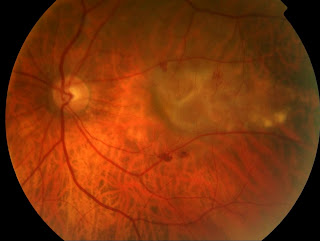An Eye With AMD Pictured Above
How do cells communicate? One method of communication is via vascular endothelia growth factor (VEGF) and VEGF receptors (VEGFRs). When a cell is low in oxygen, it sends out VEGF to the entire body. This VEGF gets caught by VEGFRs. We don't know how, but somehow VEGFRs knows where the cell sending VEGF is. VEGFRs are located on blood vessels, so when the VEGF links to the VEGFRs, a blood vessel forms a new blood vessel to the cells that need oxygen. By connecting the oxygen poor cells with the oxygen rich blood vessel, oxygen can be successfully transfered to the cells. This may seem like a helpful process, but sometimes it can be harmful. An example of this is age-related macular degeneration (AMD), an eye disease which happens to people over 50. Currently, there is no cure, and doctors recommend "not getting old." Believe it or not, AMD occurs because of this VEGF communication method. Before I get into that, we have to review the structure of an eye.
The way the human eye works is truly fascinating. To begin, light enters the eye through the pupil and travels to the cornea. The light is then focused upon the lens, who focuses the light on the back of the retina. The image the retina receives is inverse, so the optic nerve takes it to the brain to get flipped. How the brain knows the image is inverse? Nobody knows. AMD is a problem with the retina, or to be more precise, the tiny photoreceptors on the surface of the retina. The many layers of photoreceptors are composed of cells, and they communicate with VEGF. For some reason, as humans gets older, the photoreceptors in the deeper layers need oxygen, so they decide to send out VEGF. A nearby blood vessel with VEGFRs gets this message and creates new blood vessels, supplying oxygen to the cells. This process keeps happening, and slowly, the vast amount of new blood vessels start to bulge up and push the photoreceptors on the upper layers. Eventually, there is so much pressure build up occurring that the new blood vessels rupture. This causes blood to release inside of the eye, disturbing vision.
Normal Vision (Top) vs. AMD Vision (Bottom)
Scientists now know how AMD is caused, but finding a cure is not easy. If you are interesting in learning more about AMD, VEGF, or the eye, please visit the following sources.
AMD: http://www.nei.nih.gov/health/maculardegen/armd_facts.asp
http://en.wikipedia.org/wiki/Macular_degeneration
VEGF: http://www.news-medical.net/health/What-is-VEGF.aspx
The Eye: http://www.pasadenaeye.com/faq/faq15/faq15_text.html
http://www.webmd.com/eye-health/amazing-human-eye



No comments:
Post a Comment